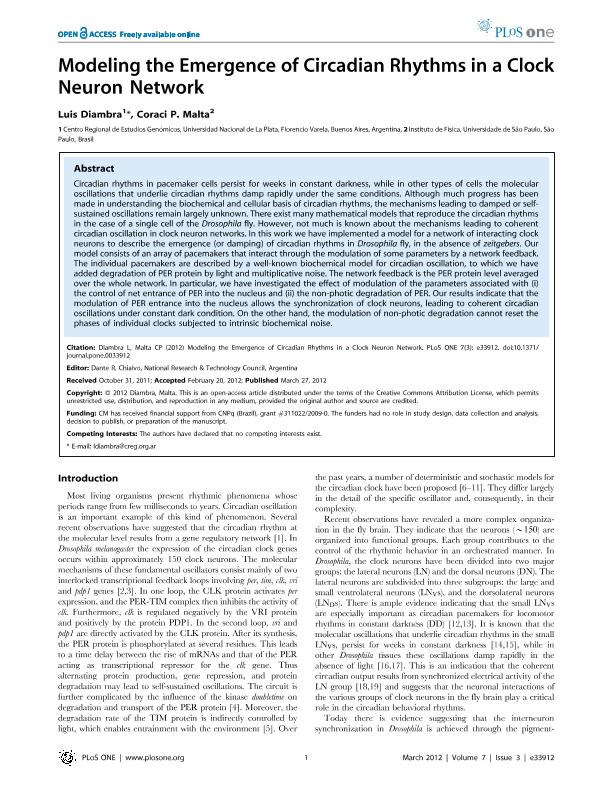Artículo
Modeling the Emergence of Circadian Rhythms in a Clock Neuron Network
Fecha de publicación:
03/2012
Editorial:
Public Library of Science
Revista:
Plos One
ISSN:
1932-6203
Idioma:
Inglés
Tipo de recurso:
Artículo publicado
Clasificación temática:
Resumen
Circadian rhythms in pacemaker cells persist for weeks in constant darkness, while in other types of cells the molecular oscillations that underlie circadian rhythms damp rapidly under the same conditions. Although much progress has been made in understanding the biochemical and cellular basis of circadian rhythms, the mechanisms leading to damped or self-sustained oscillations remain largely unknown. There exist many mathematical models that reproduce the circadian rhythms in the case of a single cell of the Drosophila fly. However, not much is known about the mechanisms leading to coherent circadian oscillation in clock neuron networks. In this work we have implemented a model for a network of interacting clock neurons to describe the emergence (or damping) of circadian rhythms in Drosophila fly, in the absence of zeitgebers. Our model consists of an array of pacemakers that interact through the modulation of some parameters by a network feedback. The individual pacemakers are described by a well-known biochemical model for circadian oscillation, to which we have added degradation of PER protein by light and multiplicative noise. The network feedback is the PER protein level averaged over the whole network. In particular, we have investigated the effect of modulation of the parameters associated with (i) the control of net entrance of PER into the nucleus and (ii) the non-photic degradation of PER. Our results indicate that the modulation of PER entrance into the nucleus allows the synchronization of clock neurons, leading to coherent circadian oscillations under constant dark condition. On the other hand, the modulation of non-photic degradation cannot reset the phases of individual clocks subjected to intrinsic biochemical noise.
Palabras clave:
Computational Biology
,
Circadian Rhythms
,
Clock network
,
Drosophila
Archivos asociados
Licencia
Identificadores
Colecciones
Articulos(CCT - LA PLATA)
Articulos de CTRO.CIENTIFICO TECNOL.CONICET - LA PLATA
Articulos de CTRO.CIENTIFICO TECNOL.CONICET - LA PLATA
Citación
Diambra, Luis Anibal; Malta, Coraci P.; Modeling the Emergence of Circadian Rhythms in a Clock Neuron Network; Public Library of Science; Plos One; 7; 3; 3-2012; 1-12
Compartir
Altmétricas




